CATALYSTS
A diverse product line featuring catalysts to support environmental remediation and catalysts used in essential daily items.
De-NOx catalysts and de-DXN catalysts break down nitrogen oxides and dioxin generated by thermal power plants and waste incineration facilities. Hydrogenation catalysts (nickel/copper catalysts) are used to produce raw materials used in margarine, shampoo, adhesives, and optical films. Polyester polymerization catalysts are used to produce raw materials used in polyester fibers, PET bottles, and PET films.
Sakai Chemical Group’s Strengths
- Sakai Chemical Industry is the only company in the world capable of integrated production of De-NOx catalysts starting from raw materials, from titanium dixoide until catalyst production. This allows us great advantages in maintaining high quality and promoting technical innovation.
- We leverage our strengths to respond to the sophisticated needs of our clients, and to continously improve our products and develop new products.
- We have long-term relationships with many clients to provide hydrogenation catalysts and other catalysts, and we apply wisdom gained through experience to expand our work to cover new clients and new products.
PRODUCT LIST
De-NOx Catalysts/ De-DXN Catalysts
■Overview
De-NOx catalysts reduce and eliminate nitrogen oxide generated by power plants and waste incineration. De-DXNs catalysts break down and eliminate dioxins generated by waste incineration. Both of these can assist with environmental remediation, and they are expected to gain increasing attention in the near future. Sakai Chemical Industry manufactures titanium dioxide, the primary raw ingredient of these catalysts. We are the only company in the world with the integrated technology capable of covering every stage from raw materials until final products like catalysts. We are confident that we have products to match every need of our clients, and we welcome new inquiries.
Sakai Chemical Industry's De-NOx Catalyst Technology
・We were awarded an Important Technology Research and Development Fund Grant by METI, followed by reconignition of our successful results.
・We were awarded the 33rd Chemical Technology Prize by the Kinki Chemical Society.
・We were awareded the 1989 Technology Prize by the Catalysis Society of Japan for "development of ammonia de-Nox catalysts for dry flue gas".
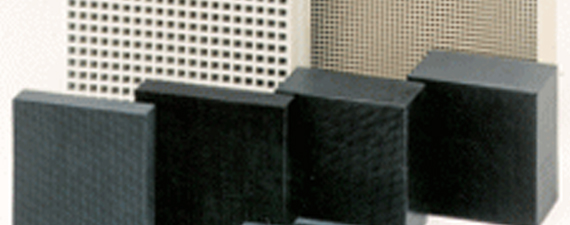
Honeycomb catalyst dimension list
| Nominal pitch | unit | 7.4 | 6.0 | 5.0 | 4.2 | 3.7 | 3.3 | 3.0 | 2.5 |
|---|---|---|---|---|---|---|---|---|---|
| External diameter | mm | 150 | 150 | 150 | 150 | 150 | 150 | 150 | 150 |
| Cell number | cell×cell | 20×20 | 25×25 | 30×30 | 35×35 | 40×40 | 45×45 | 50×50 | 60×60 |
| Opening diameter | mm | 6.23 | 4.98 | 4.13 | 3.65 | 3.19 | 2.78 | 2.56 | 2.06 |
| Inner wall thickness | mm | 1.15 | 0.90 | 0.80 | 0.58 | 0.50 | 0.50 | 0.40 | 0.40 |
| Opening ratio | % | 69.0 | 69.0 | 68.1 | 72.7 | 72.5 | 69.7 | 72.8 | 67.9 |
| Contact area | m2/m3 | 442 | 553 | 660 | 795 | 908 | 1001 | 1137 | 1318 |
| Applicable range (fuel) | |||||||||
| LNG, LPG, Kerosene |
|
|
|
|
|
|
|||
|
Oil (low-sulfur heavy crude oil) (high-sulfur heavy crude oil) (Heavy oil) |
|
|
|
|
|||||
|
Coal(high dust) (low dust) |
|
|
|
‹Gas after desulfurization›
|
|
|
|
||
|
Municipal waste(BF backwash) (Scrubber backwash) |
|
|
|
|
|
|
|||
*The data are typical values.
■Catalyst Operating Temperature

■Reaction mechanism of NH3-SCR
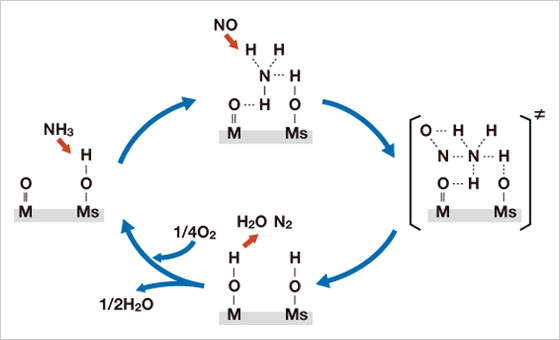
Inquiries
ADVANCED MATERIALS SALES DEP.
SALES & MARKETING DIVISION
TEL (Tokyo) +81-3-5823-3726
(Osaka) +81-72-223-4155
Hydrogenation Catalysts
■Overview
Sakai Chemical Industry's lineup includes nickel catalysts for improving the quality of oils and resins (hydrogenation), chrome-free copper catalysts, and
antimony-free titanium catalysts used to polymerize polyester.
Features of Sakai Chemical Industry Products
Sakai Chemical Industry's lineup of catalysts for chemical processing includes nickel catalysts for improving the quality of oils and resins
(hydrogenation) and chrome-free copper catalysts.
*For more information about specific products, see the tables below.
Stabilized Nickel Catalysts (SN series)
Features and Applications
| Features | Applications |
|---|---|
| Stabilized Nickel Catalyst is produced by drying, reducing, and stabilizing nickel salt from purified diatomaceous earth. It is commonly used for its hydrogenation effects on organic compounds, and features strong hydrogenation activity and high selectivity. |
|
Grade
| Grade | Features |
|---|---|
| SN-250 | High nickel content with excellent poison resistance and low-temperature activity. Used for various hydrogenation effects of fats/oils. Sharp particle distribution and excellent filterability. |
| SN-750 | Improved version of N-250 grade with high specific surface area, and high hydrogenation actitivy and selectivity. Sharp particle distribution and particularily excellent filterability after responses. Boosts efficiency of processes with repeated use. |
| SN-780 | Premium grade with highest nickel content and specific surface area. Used for hydrogenation at high temperatures and pressures. Ideal for hydrogenation of aromatic petroleum resins. |
Features and Applications
| Grade | SN-250 | SN-750 | SN-780 |
|---|---|---|---|
| Nickel content | 55 | 47 | 47 |
|
Powder properties Bulk volume(ml/100g) Specific surface area(m2/g) |
280~330 130~190 |
200~250 170~230 |
200~250 170~230 |
|
Representative example of Average particle diameter 2μm↓(%) |
5.0 5.4 |
6.7 0.2 |
6.7 0.2 |
| Fully and partial hardening of fat and oil | 〇 | 〇 | 〇 |
| Hydrogenation of double bond and triple bond | 〇 | 〇 | 〇 |
| Nuclear hydrogenation of aromatics | 〇(1) | 〇 | 〇 |
| Hydrogenation of petroleum resins | 〇 | 〇 | 〇 |
| Fatty nitriles → fatty amines | 〇 | 〇 | 〇 |
*The data are typical values.
(1) Hydrogenation of triphenyl

■Form
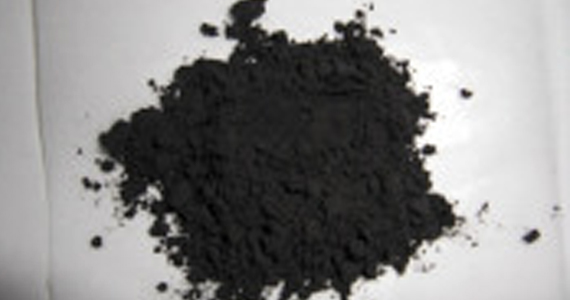
Powder
Chrome-free Copper Catalysts
Features and Applications
| Features | Applications |
|---|---|
| Developed as a substitute for a copper chromite catalysts, copper catalysts are characterized by mild hydrogenation compared to nickel catalysts. There are three forms available: powder, pellets for fixed bed reactors, and extrusions. We can make prototypes of molded models of each grade upon request. |
|
Grade
| Grade | Features |
|---|---|
| AC-1 | Copper oxide compounded with zinc. Excellent activity for hydrogenation of fatty acids, esters, aldehydes, and ketones, and dehydrogenation of alcohols. |
| AC-7 | Improved version of AC-1, good filterability. |
| ACA-1 | Improved version of AC-7, good heat resistance. |
| Grade | AC-1 | AC-7 | ACA-1 |
|---|---|---|---|
| Specific surface area | 62 | 72 | 75 |
| Bulk density(g/ml) | 0.6 | 1.0 | 0.9 |
| Average particle diameter(µm) | 12 | 27 | 26 |
| Components | CuO | CuO | CuO |
| ZnO | ZnO | ZnO | |
| - | - | Al2O3 |
*The data are typical values.
■Form
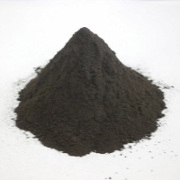
Powder
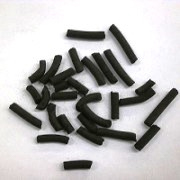
Extrusions
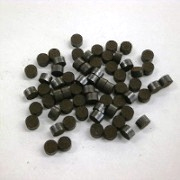
Tablets
Inquiries
ADVANCED MATERIALS SALES DEP.
SALES & MARKETING DIVISION
TEL (Tokyo) +81-3-5823-3726
(Osaka) +81-72-223-4155
Titanium Catalysts for Polyester Polymerization
■Overview
SPC series catalysts were developed as substitutes for heavy metal catalysts such as Sb catalysts. The active ingredient is a titanium compound with the
same performance as Sb catalysts.
Titanium Catalysts for Polyester Polymerization(SPC series)
Powder Grade
| Grade(Powder) | Features and Applications | Ti content(wt%) | Recommended use |
|---|---|---|---|
| SPC-124 | Standard Grade | 10 | Fibers, Films, Bottles |
Ethylene glycol dispersion grade
| Grade(Ethylene glycol dispersion) | Catalyst concentration in the dispersion(wt%) | Ti concentration in the dispersion(wt%) |
|---|---|---|
| SPC-124-30 | 30 | 3 |
Inquiries
ADVANCED MATERIALS SALES DEP.
SALES & MARKETING DIVISION
TEL (Tokyo) +81-3-5823-3726
(Osaka) +81-72-223-4155
Titanium Dioxide for Catalyst Carriers
■Overview
We leverage our strength as a titanium dioxide manufacturer to control composition and form, and to offer diverse grades featuring different surface
treatments and compounding.
Features of Sakai Chemical Industry Products
Sakai Chemical Industry manufactures titanium dioxide and is capable of integrated production from raw materials of catalysts until final products. We leverage our strength as a titanium dioxide manufacturer to control composition and form, and to offer diverse grades featuring different surface treatments and compounding. Sakai Chemical Industry will try to satisfy client requests regarding catalyst forms, such as powder and sol.
| Powder | Ultrafine particle titanium (anatase type and rutile type) with a variety of specific surface areas and surface treatments. |
|---|---|
| Sol | Used for coating agents and binders. |
| Spherical |
Spherical granules molded by roller granulation available in grades with a variety of pellet sizes and specific surface areas. Offers different response properties than alumina and silica carriers. Excellent resistance to acidic and alkaline substances. Good results as a catalyst carrier for various responses, including de-NOx catalysts. Special powder for catalysts is also available. |
Powder/Sol Applications: Photo catalysts, carriers, paints, inks, plastics, cosmetics, ceramics, electronic materials, fibers, UV shielding materials
| Grades | Crystal structure | Appearance | TiO2 Content(%) | Particle size by XRD(nm) | Specific surface area(m2/g) | Treatment agent |
|---|---|---|---|---|---|---|
| SSP-N | Anatase 100% | White powder | > 93 | 9 | > 270 | - |
| SSP-M | Anatase 100% | White powder | > 95 | 15 | 100 | - |
| CSB | Anatase 100% | Aqueous sol (nitric acidity pH‹1) |
> 30 | 7 | > 280 | - |
| STR-100N | Rutile100% | White powder | > 95 | 16 | 100 | - |
| STR-100W | Rutile100% | White powder | > 80 | 16 | 85 | SiO2 |
| STR-100C | Rutile100% | White powder | > 85 | 16 | 85 | Al2O3 |
*The data are typical values.
■TEM photo
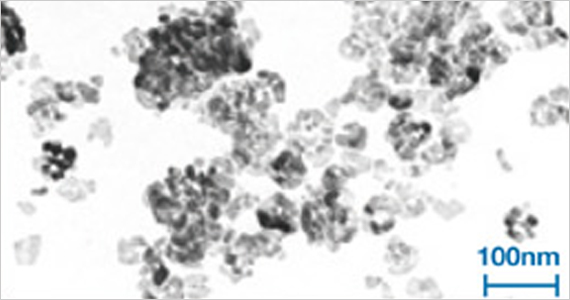
SSP-M
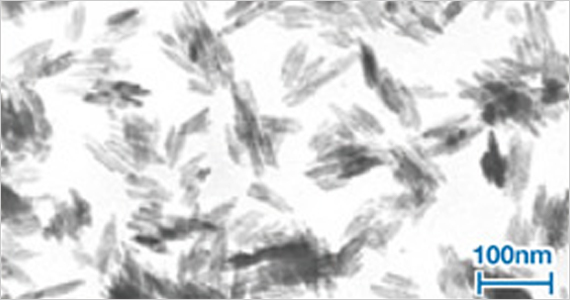
STR-100N
Spherical shape Applications: carriers
| Grades | Crystal structure | Diameter(mm) | Strength(kg/unit) | Density(㎏/L) | Specific surface area(m2/g) | Pore volume(ml/g) |
|---|---|---|---|---|---|---|
| CS-300S series | Anatase 100% | 1~6 | 0.3~3 | 0.9 | 70 | 0.4 |
| CS-200S series | Anatase 100% | 1~6 | 0.5~3 | 1.0 | 55 | 0.3 |
| CS-750 series | Anatase 100% | 1~6 | 1.5~9 | 1.3 | 30 | 0.2 |
| CS-950 series | Anatase 100% | 1~6 | 5~16 | 1.5 | 10 | 0.1 |
*The data are typical values.
Inquiries
ADVANCED MATERIALS SALES DEP.
SALES & MARKETING DIVISION
TEL (Tokyo) +81-3-5823-3726
(Osaka) +81-72-223-4155
Catalysts for Raw Materials of Synthetic Fibers (OSAKI INDUSTRY CO., LTD.)
■Overview
Since production of cobalt bromide began in 1973, OSAKI INDUSTRY has grown to manufacture and distrubute a variety of different catalysts to satisfy
demands, including aluminum nitrate.

